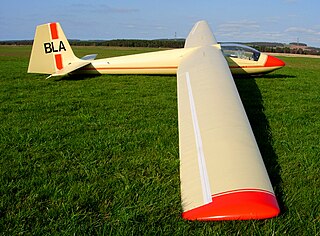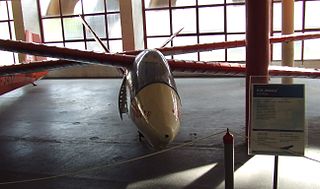Related Research Articles

The SZD-9 Bocian is a multi-purpose two-seat sailplane that was designed and built in Poland at Szybowcowy Zakład Doświadczalny in Bielsko-Biała, beginning in 1952. It was designed to be capable of fulfilling the needs of every area from training to competition flying.

The Slingsby Type 42 Eagle was a two-seat glider designed in England from 1952.

The Slingsby T.37 Skylark 1 was a small low-cost sailplane built during 1952-3 at Kirbymoorside, Yorkshire by Slingsby Sailplanes.
The SZD-8 Jaskółka was a single-seat glider aircraft that was designed and built in Poland at Szybowcowy Zakład Doświadczalny in Bielsko-Biała from 1951.

The SZD-12 Mucha 100 was a single-seat glider aircraft that was designed and built in Poland from 1953.
The SZD-25A Lis was a single-seat glider aircraft that was designed and built in Poland from 1955, derived from the SZD-16 Gil and SZD-25 Nov.

The SZD-17X Jaskółka L was a single-seat high-performance competition glider designed and built in Poland at Szybowcowy Zakład Doświadczalny in Bielsko-Biała in 1955.

The SZD-20x Wampir II was a single-seat tail-less research glider designed and built in Poland from 1959.

The SZD-22 Mucha Standard was a single-seat aerobatic glider designed and built in Poland from 1957.

The Slingsby T.30 Prefect is a 1948 British modernisation of the 1932 single-seat Grunau Baby glider. About 53 were built for civil and military training purposes.

The Slingsby Type 45 Swallow was designed as a club sailplane of reasonable performance and price. One of the most successful of Slingsby's gliders in sales terms, over 100 had been built when production was ended by a 1968 factory fire.

The Slingsby T.50 Skylark 4 was a British single seat competition glider built by Slingsby Sailplanes in the early 1960s. It sold in numbers and had success at national, though not world level competition.
The Neiva BN-1 was a high performance single seat sailplane designed in Brazil in the 1950s. It had national record and competition success and went into production for club use.

The Matteson M-1 was an American high-wing, single-seat, FAI Open Class glider that was designed and built by Fred Matteson of Palo Alto, California and Alfred Vogt of Schempp-Hirth.
The Czerwiński Sparrow, sometimes known as the de Havilland Canada glider, was a single seat glider, designed and built by a group of de Haviiland engineers in Canada in 1942. It was intended to popularise gliding and be suitable for both basic training and thermal soaring.

The Cijan-Obad Orao is a competition single seat sailplane designed in Yugoslavia just after World War II, one of the most advanced of its type at the time. It flew in three World Gliding Championships, having greatest success at its first in 1950 when it reached third place.

The Rubik R-25 Mokány, in English: Plucky person and sometimes known as the R-25 Standard (class), is a Hungarian single seat Standard Class glider of all-metal construction, first flown in 1960. It was one of a series of similar aircraft designed by Ernő Rubik. Only one was built.
The Horikawa H-23B-2 is a two-seat training glider designed and built in Japan in the 1950s. It was produced in small numbers.
The Horikawa H-22B-3 is a simple, open frame, two seat primary trainer glider designed and built in Japan in the 1950s.

The Antonov A-11 is a single-seat, high performance, all-metal sailplane built in the Soviet Union in the late 1950s. 150 were produced.
References
- 1 2 Taylor, John W R (1962). Jane's All the World's Aircraft 1962-63. London: Sampson Low, Marston & Co. Ltd. p. 318.
- 1 2 3 4 5 6 7 Shenstone, B.S.; K.G. Wilkinson (1963). The World's Sailplanes:Die Segelflugzeuge der Welt:Les Planeurs du Monde Volume II (in English, French, and German) (1st ed.). Zurich: Organisation Scientifique et Technique Internationale du Vol a Voile (OSTIV) and Schweizer Aero-Revue. pp. 54–55.
- 1 2 Simons, Martin (2006). Sailplanes 1945-1965 (2nd revised ed.). Königswinter: EQIP Werbung & Verlag GmbH. pp. 97, 99. ISBN 3 9807977 4 0.
- ↑ Hardy, Michael (1982). Gliders & Sailplanes of the World. London: Ian Allan Ltd. pp. 66–7. ISBN 0 7110 1152 4.